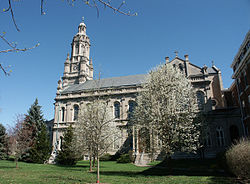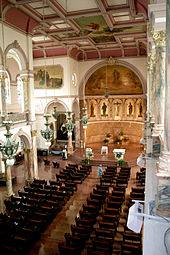- Church of the Immaculate Conception (Saint Mary-of-the-Woods, Indiana)
-
Church of the Immaculate Conception  The Church's location in Vigo County, Indiana
The Church's location in Vigo County, IndianaBasic information Location Saint Mary-of-the-Woods, Indiana
 United States
United StatesGeographic coordinates 39°30′38″N 87°27′38″W / 39.5106°N 87.4606°WCoordinates: 39°30′38″N 87°27′38″W / 39.5106°N 87.4606°W Affiliation Roman Catholic State Indiana District Archdiocese of Indianapolis Year consecrated 1907 Ecclesiastical or organizational status Chapel for the Sisters of Providence of Saint Mary-of-the-Woods Status active Website http://www.spsmw.org Architectural description Architect(s) D.A. Bohlen and Son, Indianapolis Architectural type Chapel Architectural style Classical revival Direction of façade West Groundbreaking 1886 Completed 1907 Specifications Length 154 ft Width 72 ft Width (nave) 90 ft Spire(s) 1 Materials Indiana limestone The Church of the Immaculate Conception, (Saint Mary-of-the-Woods, Indiana) is on the motherhouse grounds of the Sisters of Providence of Saint Mary-of-the-Woods. The large cathedral-like structure is the current place of worship for the Congregation and houses the shrine of Saint Mother Theodore Guerin, foundress of the Sisters of Providence.
Contents
History
When the Sisters of Providence of Saint Mary-of-the-Woods arrived in Saint Mary-of-the-Woods, Indiana in 1840, there was no church on the grounds. A primitive log cabin doubled as a chapel and a residence for the priest. About this first chapel Saint Mother Theodore Guerin, the foundress of the order, wrote to friends in France, "The Church! Yes, dear friends, that is the dwelling of the God of the Universe, in comparison with which the stables wherein you shelter your cattle are palaces!"[1]
Construction for the current church began under the leadership of general superior Mother Euphrasie Hinkle with the laying of the cornerstone in 1886. The building, constructed of Indiana limestone, was completed by architects D.A. Bohlen and Son of Indianapolis, Indiana, in 1891.
It took 16 more years before the interior was complete. By June 1892, plastering had been done and the installation of a temporary wooden floor, seats and altars permitted the sisters to worship in the edifice. Ten years later the church became the home of an organ purchased from William Schuelke Church Organ Builder of Milwaukee. (This particular organ is no longer extant.)
By 1902, the General Council, under the leadership of General Superior Mother Mary Cleophas Foley, focused its attention on the interior decoration of the church. Mother Mary Cleophas and General Councilor Sister Mary Alma O'Donald visited numerous churches in Europe to gather ideas, including the Basilica of Sant'Apollinare Nuovo in Ravenna, Italy, and the Cathedral Church of the Holy Trinity, Paris. Inspired by their travels, the two sisters returned home and soon artisans and craftsmen were employed to implement these changes.
The church was consecrated on October 23, 1907, in a celebration attended by religious dignitaries such as Bishop Francis Silas Chatard.
Under the leadership of General Superiors Sister Anne Doherty and Sister Nancy Nolan, the church was renovated in 1986 to conform with the liturgical norms of the Second Vatican Council and to strengthen the floor joists.[1]
Architecture
The Church of the Immaculate Conception is built in the Italian Renaissance style of Indiana limestone. Architect D.A. Bohlen called it "Italian Renaissance style with a French sentiment."[2]
Following the general trends of Cathedral architecture of Western Europe, it has a basic cruciform groundplan with a nave crossed by a transept. Though slightly varying from absolute coordinates, the church is positioned with a generally east/west axis. At the west front is a tall bell tower as vertical emphasis.
Internally, there is a high nave flanked by two lower aisles. Tall columns with the composite order line the nave. At the east end is the sanctuary, with red Numidian marble walls and a semi-dome above.[3] Council of Independent Colleges The floor is pink Georgian marble. The many types of marble in the church come from Italy, Africa, Skyros, Greece and the United States.[4]
Beneath the church is a crypt, officially known as Our Lady of Sorrows Chapel.
Art in the Church
Stained glass windows
On each side of the church are stained glass windows made by the Bavarian Art Institute of Munich, Germany. They portray events of Christ and his mother Mary as well as scenes from the Old Testament. The windows in the upper balcony display scenes of angels.
Stations of the Cross
The stations of the cross were some of the first items installed in the church. They were made of alabaster by Mayer and Company of Munich and London at a cost of $1,800.[5]
Paintings
Tadeusz Żukotyński (Thaddeus von Zukotynski) painted three murals in addition to the sanctuary dome. "The Ascension" at the crossing of the nave and transept ceiling shows Christ ascending into heaven. On the east walls of the north and south transepts are the "Return from Calvary" and the "Flight into Egypt." These paintings were done on canvas in Żukotyński's studio in Chicago.
The semi-dome above the sanctuary is a fresco that took Żukotyński three months to complete. It represents the Immaculate Conception of the Blessed Virgin Mary. She stands on a globe supported by clouds with Saint Michael and Saint Gabriel on either side. In the arcade beneath the dome the Four Evangelists are depicted in frescoes with gold background.
George Hepfinger of Chicago did all of the decorating and painting of the rest of the church.[6]
Altar furniture
The church renovation in 1986 included removal of a reredos (high altar) in the sanctuary. The Carrara marble was then used to create an altar, a lectern, and a presider's chair.[3]
Crucifix
Removing the reredos also opened up a space in the center wall of the sanctuary. Harry Breen of Champaign, Illinois, sculpted a triumphant Christ figure that appears to rise from the Crucifix.
Music
Pipe organ
In the upper balcony at the west front of the church is a rare pipe organ made by the Casavant Frères Company of Canada and installed in 1953. With approximately 1,700 pipes, it is the third organ that has been used in the church.[7] For its dedication on December 8, 1953, the sisters held a short organ recital featuring congregation organist and composer Sister Cecilia Clare Bocard playing her "Te Deum Laudamus".[8]
Bells
In the bell tower at the west front is a set of chimes. Made by the McShane Bell Foundry of Maryland, the eleven bells were placed in the tower in 1910. They have a combined weight of 13,150 pounds.
Originally, the bells were rung by hand to wake the Sisters of Providence, to call them to prayer and to tell them when to retire. In addition, hymns were played on the set on Sundays, holidays and feast days. The bells still are rung on the hour in addition to tolls for deceased sisters. The Sisters of Providence also ring the bells each time someone is executed by capital punishment in the United States.
In November 2004, Schulmerich Carillons installed a Generation 4 Novabell DSP cast bell controller which activates the bells. The bells, chimes and tolls are either programmed into the system or they may be controlled manually.[9]
Notes
- ^ a b Sisters of Providence Sacred Places: Church of the Immaculate Conception
- ^ Qtd. in * Brown, Mary Borromeo (1949). History of the Sisters of Providence of Saint Mary-of-the-Woods: Volume I. Saint Mary-of-the-Woods, Indiana: Sisters of Providence. pp. 752.
- ^ a b Council of Independent Colleges 2006
- ^ WoodsUp.com Art at the Woods: Church of the Immaculate Conception
- ^ Madden, p. 129
- ^ Madden p. 131
- ^ WoodsUp.com - Music at the Woods: The pipe organ
- ^ McCammon, Connie (Summer 2009). "Bringing beauty into the world". HOPE Magazine (Saint Mary-of-the-Woods, Indiana: Sisters of Providence) 4 (3): 4–5. http://www.spsmw.org/LinkClick.aspx?fileticket=rqvwaW5S%2fX4%3d&tabid=1421.
- ^ McCammon 2005
References
- Council of Independent Colleges (2006). "Church of the Immaculate Conception". Historic Campus Architecture Project. http://puka.cs.waikato.ac.nz/cgi-bin/cic/library?a=d&d=p1453. Retrieved October 28, 2009.
- Madden, Mary Roger (1991). The Path Marked Out: History of the Sisters of Providence of Saint Mary-of-the-Woods: Volume III. Saint Mary-of-the-Woods, Indiana: Sisters of Providence. pp. 121–146.
- McCammon, Connie (Fall 2005). "The bells of Saint Mary's". HOPE Magazine (Sisters of Providence of Saint Mary-of-the-Woods): pp. 4–5. http://www.spsmw.org/LinkClick.aspx?fileticket=0f9zO8ueE1E%3d&tabid=817.
- Sisters of Providence. "Art & Music". WoodsUp.com. http://www.spsmw.org/WoodsUp/ArtMusic/tabid/788/Default.aspx. Retrieved October 28, 2009.
- Sisters of Providence. "Sacred Places: Church of the Immaculate Conception". http://www.spsmw.org/SistersofProvidence/History/Sacredplaces/ChurchoftheImmaculateConception/tabid/1268/Default.aspx. Retrieved October 28, 2009.
External links
Categories:- Roman Catholic churches in Indiana
- Buildings and structures in Vigo County, Indiana
- Sisters of Providence of Saint Mary-of-the-Woods
- Visitor attractions in Vigo County, Indiana
Wikimedia Foundation. 2010.


